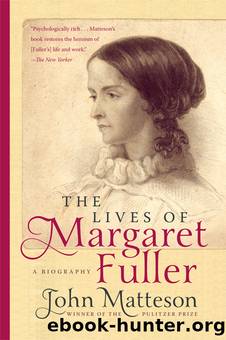The Lives of Margaret Fuller by John Matteson

Author:John Matteson
Language: eng
Format: epub
Publisher: W. W. Norton & Company
Published: 2011-12-15T00:00:00+00:00
Fuller finished Woman in the Nineteenth Century while staying with the impulsive, idealistic Caroline Sturgis. Of their times together, Fuller wrote, â[P]leasant is our independent life.â
(COURTESY OF THE INTERNATIONAL MUSEUM OF PHOTOGRAPHY AT THE GEORGE EASTMAN HOUSE, ROCHESTER, N.Y.)
Nevertheless, the work took considerably longer than the anticipated three days. Fuller redacted virtually none of the material that had gone into âThe Great Lawsuit.â She meant not to refashion her arguments, but to supplement them. If âThe Great Lawsuitâ had been the most audacious statement on behalf of womenâs rights ever written in America, Woman in the Nineteenth Century would be the most comprehensive. Fuller advised Greeley that she could not join the Tribune until December. Visions continued to haunt her. She copied into her journal an item from a Poughkeepsie newspaper titled âThe Changed,â which, she said, âexpresses so exactly my thought.â It began: âIt not infrequently happens that people, whether it arises from physical or moral causes, become wonderfully unlike themselves. Irritability, violence, indiscretion and unkindness suddenly reveal themselves in a hitherto gentle and amiable character, and, as if by a magic stroke, a beautiful form has been transformed into a witch.â49 Whether the Margaret-to-be was demon or angel, she knew she would not remain the same.
One of the reasons it took her longer than expected to complete her work was that her new environs gave her an unlikely source of new material. Fishkill Landing was not too far distant from Mount Pleasant, the womenâs division of Sing Sing Prison in Ossining, New York. One general dissatisfaction with âThe Great Lawsuitâ was that it had focused too exclusively on the intellectual life of Woman. Before she could offer a more comprehensive statement on the nature of Woman, Fuller needed to know more about the forces of passion that drew women away from the fulfillment of their divine destinies. For this reason, she was fascinated with the female inmates of Mount Pleasant, particularly those who had been jailed for prostitution. She had heard about them from her friend Georgiana Bruce, a late resident of Brook Farm who, at Fullerâs prompting, had signed on as an assistant to Eliza Farnham, the prisonâs new matron. Farnham, a liberal reformer, had taken immediate steps to better the moral condition of the prisoners, but prior to her arrival, the more boisterous of the inmates had routinely âmade [the] night hideous by singing blasphemous and obscene songsâ and had eventually attacked the former matron and ripped her clothes off.50 Fuller peppered Bruce with questions, mainly in hopes of correcting the images of prostitutes she had absorbed from romantic fiction. She specifically wanted to know what the prisoners thought about chastity. She inquired of Bruce:
You say few of these women have any feeling about chastity. Do you know how they regard that part of the sex, who are reputed chaste? Do they see any reality in it; or look on it merely as a circumstance of condition, like the possession of fine clothes? You know novelists
Download
This site does not store any files on its server. We only index and link to content provided by other sites. Please contact the content providers to delete copyright contents if any and email us, we'll remove relevant links or contents immediately.
| Books & Reading | Comparative Literature |
| Criticism & Theory | Genres & Styles |
| Movements & Periods | Reference |
| Regional & Cultural | Women Authors |
4 3 2 1: A Novel by Paul Auster(12182)
The handmaid's tale by Margaret Atwood(7626)
Giovanni's Room by James Baldwin(7096)
Asking the Right Questions: A Guide to Critical Thinking by M. Neil Browne & Stuart M. Keeley(5565)
Big Magic: Creative Living Beyond Fear by Elizabeth Gilbert(5541)
Ego Is the Enemy by Ryan Holiday(5211)
The Body: A Guide for Occupants by Bill Bryson(4860)
On Writing A Memoir of the Craft by Stephen King(4809)
Ken Follett - World without end by Ken Follett(4581)
Adulting by Kelly Williams Brown(4425)
Bluets by Maggie Nelson(4420)
Eat That Frog! by Brian Tracy(4357)
Guilty Pleasures by Laurell K Hamilton(4257)
The Poetry of Pablo Neruda by Pablo Neruda(3969)
Alive: The Story of the Andes Survivors by Piers Paul Read(3905)
White Noise - A Novel by Don DeLillo(3905)
Fingerprints of the Gods by Graham Hancock(3872)
The Book of Joy by Dalai Lama(3840)
The Bookshop by Penelope Fitzgerald(3707)
